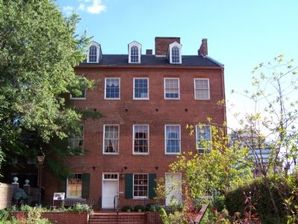Carroll Mansion
Charles Carroll of Carrollton (1737–1832), the last surviving, and only Roman Catholic signer of the Declaration of Independence, wintered here during the last twelve years of his life.
Built circa 1808, the mansion is the grandest Federal era (1780–1820) merchant’s townhouse standing in the City of Baltimore today. The ground floor was used for business and family gatherings, the second for formal entertaining, and the third for sleeping.
The mansion was sold to the Sisters of Mercy, who had come to Baltimore from Pittsburgh in 1855. By the mid-nineteenth century, German and Irish immigrants were renting rooms in the Mansion, and by 1857 a saloon was located here. It operated until 1889.
By the 1890’s, Russian Jews, many of them skilled tailors, rented rooms in the Mansion. It was transformed into a “sweatshop” for clothing manufacture. It continued as a sweatshop and home to immigrants into the early twentieth century.
In 1914, as part of the nationally sponsored Star-Spangled Banner Centennial Celebration, the Carroll Mansion was purchased by the City of Baltimore for preservation. It became the first vocational school in the city. From 1929 until 1954, the Mansion housed a recreation center. In the early 1960’s Mayor Theodore McKeldin spearheaded the effort to completely renovate the Carroll Mansion and to transform it into a publicly owned historic house museum.











